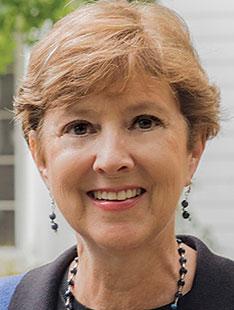Kathleen McCleery ’75, a special correspondent and freelance producer for the PBS NewsHour, was a visiting Ferris professor in the fall, teaching “Covering the Presidential Campaign.” She has covered presidential elections since 1980.
True or false? Right or wrong? The mission for journalists has long been to seek facts and report them, but President Trump’s first post-election news conference illustrates the challenges facing the media today.
The event at Trump Tower — held nine days before the inauguration, a full two months after the election — had a reality-TV feel. Insults flew. A flurry of questions related to a dossier of unverified, salacious allegations about Trump’s ties to Russia prompted the then-president-elect to lash out. The online organization BuzzFeed, which had printed the full report, was a “failing pile of garbage.” Trump accused CNN of publishing the details (it did not) and refused to acknowledge a question from CNN reporter Jim Acosta. Pointing his finger, he shouted that the network was “terrible” and “fake news.”
Acosta’s peers — competing for headlines and scoops —didn’t come to his defense. Most, presumably, wanted to pose their own questions; only 16 out of the 350 in attendance got a chance during the hour-long affair. It was a divide-and-conquer strategy, and it worked.
It did not get better from there. On his first full day in office, Trump accused the media of being “among the most dishonest human beings on earth,” claiming journalists had invented a rift between him and U.S. intelligence agencies. His press secretary, Sean Spicer, angrily scolded journalists, saying they lied about the size of the inauguration crowd — even though the media’s assertions were upheld by photographic and other evidence. Senior adviser Kellyanne Conway said Spicer had presented “alternative facts.” A day later, at Spicer’s first official White House briefing, he called the coverage of the new president “demoralizing” and, when asked if he’d be truthful, said, “Our intention is never to lie to you.” Hours after that, Trump told members of Congress ballots cast by 3 million to 5 million immigrants living in the country illegally had cost him the popular vote, a false claim.
For months, candidate Trump had taken control of the narrative and the press. The candidate blocked some news organizations, including The Washington Post and Politico, from getting media credentials to cover his events. He harassed reporters, including a disabled one, in person and via Twitter. Nearly every rally included a broadside directed at the press. In May 2016 in Albuquerque, N.M., this reporter was perched on the camera platform when Trump exhorted the crowd to “look at them, the dishonest slime.” Hundreds turned and booed. In November, a Trump supporter at a Minnesota rally sported a T-shirt that read: “Rope. Tree. Journalist. Some assembly required.” Long before he secured his party’s nomination, Trump called for loosening libel laws, a move that prompted worries about First Amendment protections. In mid-January, the Society of Professional Journalists declared that Trump’s “words and actions threaten the underpinning of democratic society: an independent press and freedom of speech.”
Facts are journalists’ most valuable tools. Operating in what some described as a “fact-free universe” — with fact-checkers debunking many of Trump’s claims — many journalists covering the campaigns deserved plaudits. They scoured speeches, debates, and tweets, often in real time on multiple platforms. The Pulitzer Prize-winning PolitiFact rated 70 percent of Trump’s statements as mostly or completely false, some getting its “Pants on Fire” score. Washington Post reporter Jenna Johnson, who spent months following Trump, said the GOP candidate made it tougher for the press to be gatekeepers. “It used to be that [when] you cover a candidate and they say something that is inaccurate, you call them out on it, and they stop saying it. With Donald Trump, he doubles down on those things and keeps saying them,” she said.
So much attention focused on truth-telling that the Oxford Dictionaries’ word of the year was “post-truth,” defined as an environment “in which objective facts are less influential in shaping public opinion than appeals to emotion and personal belief.”
When Trump used the phrase “fake news” to describe CNN, he equated a mainstream organization with online hoaxes. Real journalists weren’t fabricating stories during the campaign, but real people did read the made-up ones: Pope Francis endorsed Trump. Hillary Clinton sold weapons to ISIS. A pizza joint in a tony Washington, D.C., neighborhood hid a child-sex ring linked to Clinton and her former campaign manager, John Podesta. The seemingly incredible tales mimicked reality and got hundreds of thousands of clicks, though it’s unclear how many were believed.
“We don’t need you guys anymore,” former Vice President Dick Cheney told CNN. He was referring to Trump’s use of Twitter, which gives news consumers information in tidbits of 140 characters or less. The moniker “Twitter President” took hold months before Trump won office. His tweets — many in capital letters with exclamation points — offered policy pronouncements as well as personal views. With more than 22 million followers, his unfiltered messages kept the press corps moving to new topics with little time to reflect and examine what had been said. “We should be using this as a news resource about the candidate, but at the same time, that’s really dangerous ground ... it’s a one-sided conversation,” said Christina Bellantoni, associate managing editor of the Los Angeles Times.
All this comes as trust in the media has hit an all-time low. A December 2016 NBC News/Wall Street Journal survey found that 55 percent of respondents had “very little or no confidence” in the national news media. About 38 percent told Pew the press deserved a failing grade for campaign conduct; only 22 percent gave it an A or a B.
A reporter for Breitbart News Network, a right-wing organization that had a front-row seat at the pre-inauguration news conference, asked Trump what reforms he’d recommend for the industry. Trump said he hoped for people who “have some moral compass,” then denounced some in the room as “very, very dishonest” and ended with a plea for “honest reporters.”
Honesty is important. So is tenacity. Reporters need to be aggressive. Be transparent. Ask questions, follow up, demand answers. Report on debates, but don’t engage in them. Focus on issues over style or spectacle. Be a troublemaker. Consider whether to report everything the president says — not every word or every tweet is newsworthy. Rethink live coverage of news conferences. Use news judgment to determine what’s important and what’s not.
Find new techniques for detecting fake news — using people, not just robots, because though algorithms designed to ferret out false stories can be useful, they can fail to spot nuances. Pressure social-media giants like Facebook and Google to remove made-up stories.
And don a bulletproof vest when insults fly.
None of that is easy, but it’s possible. The roller-coaster ride of the past year brought more coverage, investigation, and analysis than ever before. Months of digging by Washington Post reporters, in particular, yielded details about Donald Trump’s business dealings, reality-television programs, and political pursuits, all cataloged in the biography Trump Revealed, co-authored by Marc Fisher ’80. Hundreds of hours of interviews went into the two-hour Frontline documentary “The Choice 2016.” Examples of exemplary reporting abounded on air, in print, and online. There was no shortage of information, but much of the public didn’t read, watch, or believe the stories.
News organizations need better, more creative ways to capture views and spread the news. Well-researched investigations have limited impact if they don’t capture a large audience. It’s not enough to post to Facebook, Twitter, Instagram, Snapchat, or whatever new social network emerges.
Voters have a responsibility, too. To assure truthful and fair reporting, voters must be willing to ante up. Shoe-leather reporting takes resources. No matter where it comes from — advertising, subscriptions, or grants — funding is key. American citizenship requires a commitment to an independent, free press.



